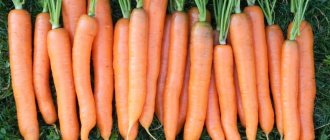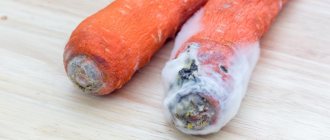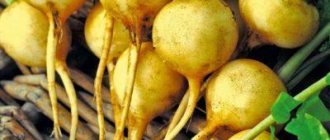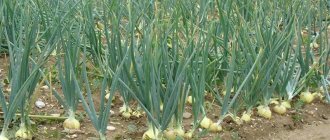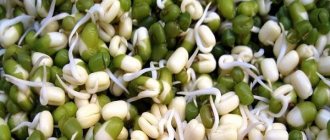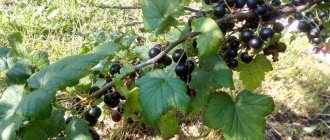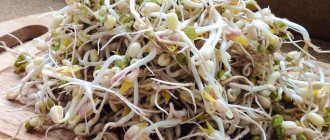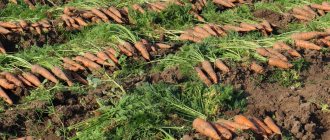What are black carrots? From a biological point of view, this is the Spanish scorzonera (Scorzonera hispanica), nicknamed the “black root”. The plant belongs to the Asteraceae family, genus Asteraceae. It has been grown for many years in the southern countries of Europe and Asia. In Russia, black carrots became known several years ago and are gaining popularity in the south of Russia, Western Siberia and the Caucasus.
In terms of biological properties, it is closer to chicory than to carrots. It has been grown as a cultivated plant since the 19th century. In nature it grows as a herbaceous shrub up to 1 m tall, blooming with bright yellow flowers. Black carrot juice has an antiseptic effect and is used as an antidote for snake bites.
Black carrots - an exotic root vegetable
The black root vegetable is not inherently a carrot. This is scorzonera, which is very popular in America today, and is also cultivated in Eastern countries.
Since the 16th century, scorzonera has been actively grown in the Mediterranean, it was used not only in cooking, but also in medicine, as the main ingredient in many medicines.
Additional Information! Scorzonera is a perennial plant in the wild, cultivated as a biennial crop. Other names for the vegetable are sweet root, Spanish root, and goat.
General characteristics of the vegetable, description of appearance
Scorzonera has several varieties that differ in appearance and size.
General description of black carrots:
- stems are dark green, 30-70 cm high;
- root vegetable - length about 15 cm, diameter up to 5 cm, weight from 150 to 200 g, the skin of the root vegetable is black, and the pulp is tasty, juicy and white;
- inflorescences are bright yellow.
Scorzonera flowering is beautiful and unusual
Black carrots are known for their beneficial properties:
- helps speed up metabolism;
- removes toxic substances and waste from the body;
- improves visual acuity;
- reduces blood pressure;
- has anti-cold and anti-inflammatory effects.
Additional Information! Scorzonera is a dietary vegetable that is recommended for diabetics. In ancient times, an antidote for viper bites was made from the root vegetable.
The benefits and harms of root vegetables
The vegetable is rich in vitamins B and C, iron, calcium and other microelements. It contains inulin, which affects the level of cholesterol in the blood, as well as a number of biologically active components that improve the functioning of the heart, stomach, intestines and kidneys. Therefore, it is very often used for the production of medicines.
Scorzonera has no contraindications. But in any case, when using the root vegetable for the first time, you should be careful, as you may develop an individual intolerance. Also, in some cases, the root vegetable can produce a slight laxative effect.
Differences between black carrots and traditional varieties
What they are: Black carrots are not the traditional orange root vegetable, although they look very similar. This is a completely different culture, which has a number of differences from ordinary carrots:
- belonging to different families - carrots are Umbelliferae, scorzonera are Asteraceae;
- different shapes of leaf blades; in black culture, the leaves can be lily-shaped, entire-edged or lily-lanceolate;
- different taste - scorzonera has a taste of black radish, hazelnuts or asparagus.
Another difference between black and orange carrots is that the first crop has more powerful, pronounced medicinal properties.
You can distinguish scorzonera from carrots by the appearance of the tops
Growing conditions
Scorzonera loves fertile, loamy or sandy loam, moderately moist, neutral soil. Requires deep loosening of the soil. Does not tolerate fresh manure. Excess organic matter affects the shape of the roots - they begin to branch.
Planting a crop
Sow scorzonera directly into the garden bed, in the spring, at the end of April, at the beginning of summer or in August - before winter. For spring planting, soaked or slightly sprouted seeds are used. Pre-seed material can be treated in a weak solution of potassium permanganate.
Sow scorzonera seeds as soon as the soil warms up and dries. They germinate at a temperature of 5-6 degrees Celsius. Before the scorzonera shoots emerge, the planting is covered with plastic film on wire arches. When sown in spring, seeds germinate in 8-15 days. It is important not to delay sowing. The sooner the seeds are sown, the larger the roots will grow. During summer sowing, the root crops are small, so they are often left in the ground until next spring.
To obtain planting material, scorzonera is sown in early August. The plants will have time to take root before autumn. Before wintering, they are covered with dry leaves or straw. In the second year, large root crops are formed, and at the end of summer the seeds can be collected. The shelf life of seeds is no more than 2 years.
Ripening time
Scorzonera can be harvested for consumption in the summer, and for storage - from the beginning of October. Root crops are usually dug up after the first frost. The ripening period is 120-140 days.
Productivity
The weight of one root vegetable is about 60-100 grams. From a row one meter long you can harvest 1-2 kilograms of scorzonera.
Soil preparation
The soil is dug up and loosened before planting. The digging depth is 35 centimeters. The soil should be loose and light, otherwise the roots will grow crooked. You can add a little peat or sand to the garden soil. For spring sowing, the soil is fertilized with manure in the fall (0.5 buckets of humus per square meter of land). A few days before planting, a little wood ash (310 grams), superphosphate and potassium nitrate (40 grams per square meter) are added to the soil. The culture does not like lime.
Sowing scheme
Scorzonera can be sown in different ways: in rows or in strips. Shallow grooves are made in the ground. In the spring, the seeds are buried 1-2 centimeters into the soil, and in the fall they are buried 3 centimeters. With any method, a passage of 60 centimeters is left every 2-4 rows.
Tape
With the ribbon method, scorzonera seeds are sown in long ribbons. Each such tape can have 2-4 rows. Leave 10 centimeters between adjacent plants in the same row. And the distance between the tapes is 50 centimeters.
Rows
Black carrots are sown in narrow or wide rows. With the narrow-row method, 10-15 centimeters are left between neighboring plants. The distance between rows is 20 centimeters. With the wide-row method, the beds are freer. The distance between the rows is 30-40 centimeters.
See also
Is it possible to plant carrots in July or at the end of June, favorable days and care rules
Read
Features of cultivation
Landing dates:
- spring - the harvest will be received this year;
- summer - root vegetables will appear in the second year, when the vegetable takes root normally and overwinters;
- autumn - when planting in autumn, the harvest can be harvested earlier than when planting in spring; the first shoots will appear within 7-9 days after planting.
Attention! For scorzonera, only the seed growing method is used.
Planting black crops is no different from planting carrots:
- the earth is dug up, complex mineral fertilizers or wood ash are added to it;
- furrows about 2 cm deep are made in the soil, into which the seeds are placed;
- the beds are covered with earth and watered;
- As soon as shoots appear, the soil needs to be mulched and the planting should be thinned out if necessary, leaving a distance of about 15 cm between the bushes.
It is recommended to plant black carrots on a tape. It is recommended to soak the seeds for 5-7 hours before planting to speed up their germination.
Everything about scorzonera is unusual, even the shape of the seeds.
Scorzonera care includes:
- regular watering - carried out as the top layer of soil dries out;
- loosening after each watering;
- timely removal of weeds;
- fertilizers - complex mineral fertilizers, applied for the first time 30 days after planting, the second time - after 1 month, before the second half of the growing season, when spilling, it is recommended to add an infusion of wood ash (1 liter of tincture per 10 liters of water).
Additional Information! Scorzonera tolerates frost well. When grown in the southern regions, it does not require shelter.
Carrot ripening time, yield
Ripening time depends on the variety, on average it is 100-120 days from the moment of germination. The yield is about 1.5-2 kg per 1m2.
Use in cooking
The vegetable has an unusual taste; its structure is similar to radish, and it has a sweet taste with the smell of vanillin. It is added to soups and salads, eaten fresh, boiled and stewed. If you add salt to the water during cooking, the vegetable acquires a slightly salty taste.
The pulp of the root vegetable is white and juicy. Seasoned with sunflower or olive oil, it is more useful than boiled. In general, scorzonera is used like regular carrots: seasoned with main courses, added to hot soups. Its unusual flavor adds piquancy to the dish.
The taste of Spanish carrots goes well with meat and fish dishes and other vegetables. Some varieties with a purple tint are used to tint marmalade and fruit jellies.
Problems when growing black carrots
Problems when growing crops arise due to incorrect agricultural practices:
- small size of fruits or their deformation - lack of thinning, planting on poor soil;
- rotting of root crops - excessive watering;
- infection by fungal diseases - high humidity.
Other problems that a gardener may encounter if they do not properly care for scorzonera are hairiness of root crops and their cracking, the cause of such phenomena is insufficient watering.
Hairy root vegetables can be eaten, but they are not suitable for storage.
Common gardening mistakes
Mistakes that should not be made when growing scorzonera:
- using fresh manure as a top dressing;
- planting a crop on the ground where cabbage, spinach, tomatoes and carrots previously grew;
- planting black carrots on rocky and clayey soils - the root crops will be deformed - the crop should grow on loose, nutritious soils.
Attention! Excessive soil moisture and prolonged drought should not be allowed.
ethnoscience
Thanks to its composition rich in nutrients, sweetish scorzonera is used for the prevention and treatment of various diseases. Healing drinks are prepared from roots and leaves. In its medicinal properties, the culture resembles ginseng.
Black carrot juice
The milky juice and grated pulp of the roots are used to treat purulent wounds. Lotions with fresh juice help even with periodontal disease. Scorzonera promotes the removal of gallstones and kidney stones. To do this, mix the juice in equal proportions with honey and drink one tablespoon before each meal for several weeks. The juice is prepared as follows: the root vegetables are peeled, crushed, and the liquid is squeezed out of the resulting pulp.
See also
50 best varieties of carrots with descriptions and characteristics
Read
Leaf decoction
To prepare the decoction, take 20 grams of crushed leaves and a glass of water. The greens are boiled for 15 minutes, then left for another 32 minutes. Filter before use. The decoction is useful for colds. They treat skin diseases, gout, and wash wounds.
Root decoction
Useful for bronchitis and for treating the liver. Take a glass of boiling water for one tablespoon of chopped root vegetables. The roots are boiled for ten minutes, then left for 30 minutes. Take one tablespoon three times a day.
Infusion of roots
An excellent remedy that helps improve the health of the body, cure the liver and gall bladder, and increase potency. Two tablespoons of crushed root are poured into a thermos and poured with two glasses of boiling water. Leave for a day, take before meals.
Harvest and storage
Ripe root vegetables are harvested in the fall. You need to dig them up very carefully, because the roots are delicate and can be easily damaged. Preparing vegetables for storage:
- cleansing root crops from the ground;
- discarding damaged specimens;
- cutting off the tops.
It is recommended to collect root vegetables in small bundles of several pieces. You can't wash vegetables. The optimal place for storage is a basement or cellar. Root crops are placed vertically in a box and covered with earth. The room temperature should not rise above +10 °C.
Additional Information! If there is no cellar, you can store the harvest in the garden bed, burying it in the ground and covering it with a layer of about 20 cm of leaves on top.
Although scorzonera is not a carrot, both crops have identical planting rules and agricultural practices. Black root vegetables diversify the diet, add unusual, piquant notes to dishes, and benefit the body.
Botanical characteristics of scorzonera
It is a one- or two-year-old plant that is usually grown for its dark-colored roots and lush rosette of green oblong leaves. For its sweetish and delicate taste, the Romans dubbed it licorice. Another name for the crop is black carrot, goat, winter asparagus.
general description
Scorzonera: what is it? A two-year-old crop from the Astrov family. In the first season, a long root and a lush rosette of oblong leaves grow. The next day, flower-bearing thin stems and seeds appear. The flowers are large, yellowish, smelling pleasantly of vanilla, similar to dandelions. The flowers are collected in inflorescences. The branched stem can reach a height of one meter. The leaves are basal greenish lanceolate or pinnately dissected.
The root is a taproot. Length - 33-40 centimeters. The long, thick root vegetable is covered with dark, rough skin on top. Inside there is light pulp, rich in milky juice. The diameter of one such root crop is 2.15-4.0 centimeters, weight - 62-70 grams.
The growing season in the first year of life is 120-140 days. The plant is winter-hardy and tolerates winter well if it is covered with dry leaves before wintering. The next season, the culture develops over 120 days.
Places of growth
The homeland of dark scorzonera is considered to be southern Europe and Asia. Wild forms of this plant, and there are about 150 species, grow on sandy, limestone, rocky soil in the southern states. In Western Europe, scorzonera began to be grown only in the 17th century. The ancient Greeks were the first to notice the healing properties of the culture.
In Russia, this plant is a rare guest in the garden. True, in Crimea they know and love the sweetish scorzonera; they prepare various dishes from it. It is also cultivated in America.
Compound
Scorzonera is the most valuable crop in its composition. It contains a lot of potassium, calcium and phosphorus, as well as various vitamins. The culture is rich in carbohydrates and proteins. Scorzonera roots contain inulin (almost 10%) - a natural polysaccharide. This substance improves the functioning of the digestive system, cleanses the body of toxins and bad cholesterol. Inulin gives root vegetables a rich, creamy taste and is a good substitute for natural coffee.
Taste qualities
These carrots are rarely consumed raw. It tastes like a cabbage stalk or a young walnut. Boiled or fried scorzonera is a completely different matter. This is an exquisite delicate delicacy. The cooked root vegetable tastes similar to cooked asparagus. Perhaps this is why the plant was called winter asparagus. True, the taste of scorzonera improves if the root crop sits in the garden until the first frost.
What does it look like
Kozelets is a herbaceous plant with a rosette of large, wide leaves, pointed at the tips. The leaves are covered with fluff. The flower, or rather the inflorescence, resembles a dandelion, and after flowering it also turns into a white ball with flying seeds.
The root vegetable for which scorzonera is grown really resembles a carrot, only it is colored brown or black. The length of a mature root reaches 35 cm, thickness – 1.5 cm.
Attention!
Do not confuse scorzonera with blackroot - a poisonous plant from the Borage family with an unpleasant odor and dirty red or purple flowers collected in a panicle.
Main problems
During the growth process, you may encounter various problems: plants may grow poorly or wither. Leaves may turn yellow, dry out, or become spotted. At the very beginning, you need to determine the cause of the problem and only then outline ways to fix it. Usually, black carrots get sick or grow poorly if agrotechnical growing rules are not followed.
Soil waterlogging
If the soil is filled with plenty of water, all the beneficial additives will be washed away. In waterlogged soil, the roots will begin to rot. Strong moisture will provoke the development of fungal or bacterial infections. Diseased plants will wilt and turn yellow.
Lack of moisture
If the soil is not watered, the crop will begin to dry out. Salt crystals cannot enter the plant. Black carrots will be devoid of nutrients. The roots will grow small. Moderate and timely watering will ensure normal development of root crops.
Excessive thickening
Scorzonera does not tolerate shading or too dense plantings. It is advisable to thin out the bed, otherwise the root crops will grow small. The optimal distance between neighboring crops is 10 centimeters.
Insect pests
Sweet-tasting root vegetables can be spoiled by crawling, ground-dwelling, and flying insects.
Slugs
Crawling insects. Coniferous mulch protects against slugs. The ground around the scorzonera can be watered with vinegar, sprinkled with mustard powder and ash.
Medvedki
Ground-dwelling insects. Insecticides (Aktara, Confidor) or garlic tincture can save you from them. Water the soil near the plants with insecticidal solutions.
Nematodes
Small worms that live in the ground. They feed on root crops and make tunnels in them. To kill insects, solutions are prepared based on Mercaptophos, Lindane, and Phosfamide.
Mole
An insect similar to a butterfly. Lays eggs on leaves from which caterpillars emerge. They feed on black carrot leaves.
To combat insects, spraying with insecticides and dusting with wood ash is used.
Diseases
Due to a lack of nutrients in the soil or in rainy weather, plants may weaken and become sick. Roots and leaves are affected by fungal and bacterial infections.
Various types of rot
It mainly affects root crops during storage. Rotten dark or grayish spots appear on the roots, consisting of fungal mycelium. To combat rot, fungicides (Fitosporin) are used.
Bacteriosis
An infection that causes root vegetables to soften. Rarely affects roots in the soil, more often it occurs during storage. For prevention, plants are sprayed with a solution of potassium permanganate and sufficient potassium and phosphorus are added to the soil.
Cercospora
Numerous light or brown spots are visible on the leaves. Preventive treatments with a solution of potassium permanganate, colloidal sulfur or fungicides (Fitosporin, Quadris) can help prevent fungal disease.
Varieties
Unlike European countries, breeding work in Russia is carried out on a very limited scale. There are several old varieties (Ordinary, Russian Giant, Vulcan). The State Register of Russia includes 3 varieties: Overseas Delicacy, Medicinal and Solar Premiere. The last two are the most popular.
- Sunny Premiere is an early ripening variety. The dark brown root vegetable weighs about 80 g and reaches 32 cm in length. From 1 m2 you can harvest up to 2 kg of root vegetable.
- Medicinal - ripens a little later than Sunny Premiere. Long root vegetables also reach a weight of 80 g, the flesh is white and sweetish.
In large cities (Moscow and St. Petersburg), seeds can be purchased in special stores. Sometimes they are found in supermarkets. You can also order seeds through the online store. The price of a 0.5 g bag is usually 16-20 rubles, but there are also more expensive options.
Disease and pest control
The main diseases that affect black carrots are white, gray and black rot, brown spot and cercospora.
- Plaque on the leaves is gray rot, which can be easily prevented by frequent loosening of the soil or treatment with copper sulfate.
- Curled tops and yellow spots on the tops (black rot, brown spot) are treated with Rovral or nettle decoction by spraying.
- Bordeaux mixture is used to treat cercospora, which can be identified by gray spots.
Brown spot
To repel insect pests, plants are sprayed with a solution of laundry soap or infusion of tomato tops. This is an excellent remedy for moths and psyllids. Nematodes are fought with a stronger remedy - the drug Dekaris.

